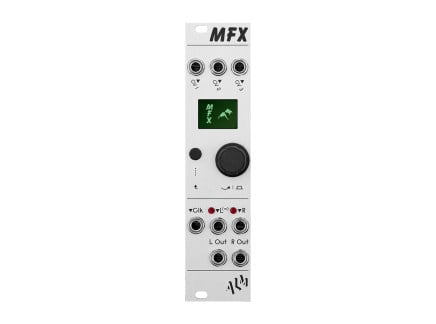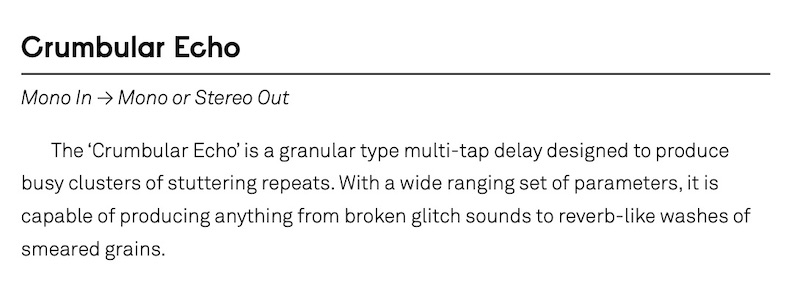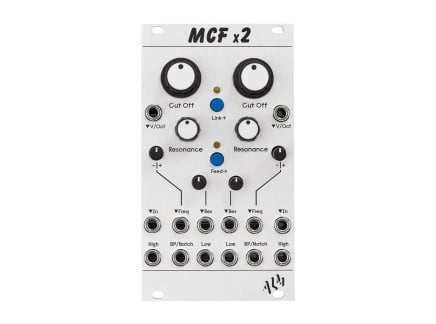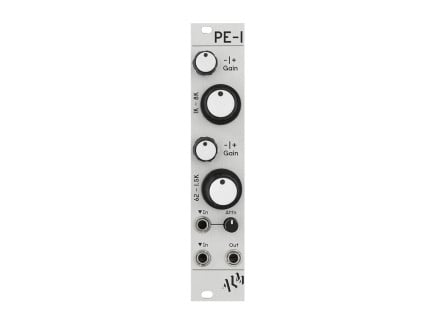ALM Busy Circuits has announced the availability of their new Eurorack multi-effect module, the MFX. A mere 6hp wide, MFX packs delays, reverbs, compression, pitch shifting, and much more into a petite form factor. But with effect types based on classic rack gear from the 1970s onward and entirely new effects ranging from granular echoes to brutal glitch and distortion effects, MFX is much more than the typical multi-effect: each algorithm delivers unique character and charm sure to entice.
Its simple interface belies its complexity, but don't be fooled—this module is immensely programmable and capable of fitting into virtually any Eurorack modular synth we can imagine. If you're looking for a compact-yet-versatile effect process, I can officially say that MFX is my personal top recommendation. For that matter, if you're an effect lover who is curious about modular synths, this would be a heck of a place to start.
I'd like to draw a quick comparison between MFX and Pamela's New Workout—ALM's wildly popular and highly-programmable clock/modulation source. I can't help but see these two in a similar light: while Pam's New Workout is a remarkably powerful CV and clock source, MFX seems to apply the same level of flexibility to the concept of effect processing...providing all the effects you need in a small space. Whereas Pam's is a multi-channel device with individual assignable behavior for each output, MFX can only wield one program at a time, but as we go on, you'll see that each internal effect algorithm can do a lot. So, I'll attempt to quell my gushing for the moment in order to describe what MFX is, and what it can do for you.
ALM MFX: My Favorite New Eurorack FX Processor
ALM's MFX is a stereo effect processor with multiple internal effect algorithms. Key points to note: it retains its settings between power cycles. It offers factory presets and user presets for each effect type. It has true stereo I/O (though some algorithms use these in different ways than pure stereo input/output). It has a USB-C jack for future firmware updates (an exciting prospect).
It's a mere 6hp wide, but it still packs in a full complement of features—including an OLED display, tuner and scope modes, dedicated clock input (whose function varies depending on the selected algorithm), and three dedicated assignable CV inputs (with internally assignable attenuation and offset settings!). That's not all though...MFX is also compatible with the Axon-1 expander, making it possible to add four additional CV inputs...each of which can be assigned to as many parameters as you like. So, while the only hands-on controls are managed via the single onboard encoder, there's nothing keeping you from getting super deep animating your effects. Heck, even just pair with a bunch of voltage offset generators and you've suddenly got a much more hands-on, traditional effect experience.
Generally speaking, ALM modules carry a strong association with early digital sound quality—a hi-fi-of-yesteryear sound that to modern ears has a certain charm, grit, and fizz. Even analog processors like the Mum M8 and PE-1 emulate some of the noisy and weird aspects of '80s/'90s music gear (the Akai S950 sampler and Tascam Portastudio series, respectively). MFX continues this tradition by emulating the sound of several vintage rack units and synthesizer effects, like the Ursa Major SST-282 Space Station, Alesis Quadraverb, Roland Juno chorus, Solina ensemble, and many more. But MFX doesn't stop there—it adds its own unique twists to each of these classic effects, and offers a wide range of completely new effects for the sonically adventurous. In the video below, you can see a demo of each of the current algorithms—and from here on in the article, we'll talk through the various algorithms to see what they have to offer.
At the time of its announcement, MFX ships with contains a lot of different types of effects—for the sake of listing them, I'm going to group them into four categories: delays, reverbs, dynamic effects, and modulation effects. Keep in mind that ALM is planning future updates—so it's likely that more effect types will eventually emerge. But for now, let's take a look at each of the algorithms available as of the release date. Also, keep in mind that many algorithms feature multiple selectable modes...so there's a lot hiding behind that 6hp faceplate.
ALM MFX: Delay Algorithms
First, let's talk echoes: MFX includes a Digi-PCM Echo, Tape-Tech Echo, and Crumbular Echo. The Digi-PCM Echo is inspired by early digital rackmount delays, offering a wide variety of options for delay modes and audio quality. As you might expect, there are Mono, Stereo, Ping Pong modes for the Digi-PCM Echo...but there is also a Dual Tap option (which uses a pair of delay lines, summed to a mono output), and and external feedback mode which repurposes the right input/output channels as a send/return for the delay feedback loop, allowing you to add external effects into your delay line. The delay can sync to an external clock signal, and allows for time multiples of the incoming clock rate. There are high and low cut tone controls, modulation with controllable rate and depth, variable sample rate and bit depth, and even a buffer reverse option...and keep in mind, that is all a single effect type: the Digi-PCM Echo.
The Tape-Tech Echo was designed to emulate the eccentricities of tape delays. It features typical time/feedback controls and optional external clocking (with clock multiplication)—but rather than the distinctly digital sample rate/bit depth controls of the Digi-PCM mode, we instead get Tape Age and Wow + Flutter controls, adding noise, saturation, and general warble/chorusing to your repeats. The Tape-Tech Echo also features a built-in pitch shifter, shifting the delay pitch without impacting the delay time. This allows for loads of characterful pitch shifted delay tricks.
The Crumbular Echo, though, is a different beast entirely: it's a granular multi-tap delay that creates clusters of repeats for everything from glitchy stutters to pseudo-reverb effects. Parameters include delay time, "spray" (a random time offset for each grain), density (amount of grains), and size (size of the grains). There are dedicated feedback, high cut, and low cut parameters—and while this mode doesn't feature clock sync, it's really more about experimentation. Carefully combining different settings, you'll discover a wide range of unusual and gnarly effects.
ALM MFX: Reverb Algorithms
The first reverb-esque program is the Ursa Minor Echoverb, which—depending on the selected mode—can act as either a multi-tap echo or a pseudo-reverb. We presume this setting is based on the Ursa Major SST 282 Space Station, one of my personal favorite bizarre old rack effect processors.
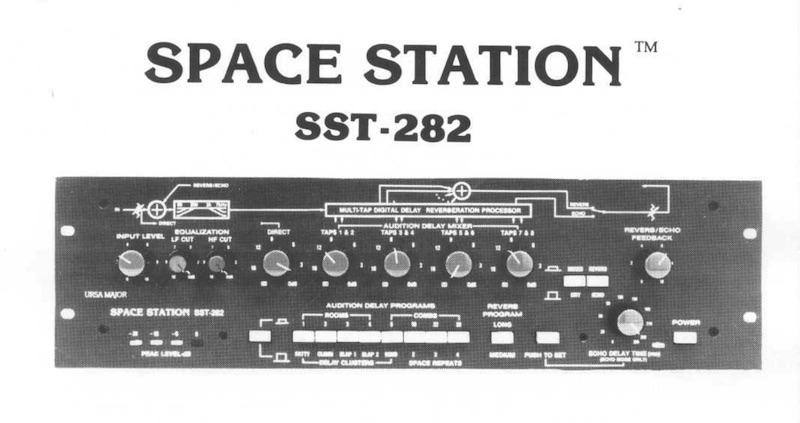
This effect combines eight delay taps in an assortment of 20 distinct "programs," which correspond to different pre-set timing configurations for the delay taps (with variable timescale in the "echo" mode). The taps are organized such that they are hard-panned left and right in stereo pairs—and you're given variable level control of each of the four stereo pairs independently. You also have controls for feedback amount, high cut, and low cut. This may seem simple, but with all the available tap timing configurations and those per-tap-pair level controls, you'll be able to get a huge range of effects from stammering repeats to uncanny, smearing sonic spaces. I'm super excited to try this program out with a bunch of CV inputs.
The Pocket PL8 Reverb endeavors to provide the sound of aluminum plate reverb by emulating the inner works of early digital reverbs based on the iconic electroacoustic effect. The control set for this program is quite simple, with only size, pre-delay (up to 99ms), high cut, and low cut controls with optional mono or pseudo-stereo operation (achieved via phase inversion). Interestingly, in this mode, the clock input can be used to gate the reverb tail...which I'm sure will make for a wide host of interesting rhythmic effects.
The Almicon Reverb evokes the unreal, lush, and vast spaces found in vintage Lexicon units. Like those units, it has a deceptively small number of parameters—just size, damping, pre-delay, and diffusion—but these combine for a huge range of sounds. All parameters in some way affect the perceived size/density of the "space," so there are a ton of ways of creating a sense of movement/transformation, especially under voltage control. The Quaidra Reverb, which we can only assume is inspired by the Alesis Quadraverb, is a straightforward way of creating insanely large, open-sounding spaces. It offers size, damping, and low cut parameters, and is a great go-to for infinite reverb at large sizes and low damping values.
ALM MFX: Dynamic Effects + Distortion
Then come the dynamic effects! The TY-50 Compressor is a stereo compressor great for everything from individual sounds to your master mix bus. It features all the parameters you'd expect—threshold, ratio, attack, release, and make up gain—and can optionally display the instantaneous gain reduction and output gain on the OLED screen. There's also a handy way of bypassing using the back button and encoder, great for A/B-ing your settings with the unaffected sound. The Transient Shaper program is designed to provide tailored control of the attack and release of your sound—like a compressor for adding snappiness to the fronts and ends of individual sounds. Using attack, release, tilt EQ, and make up gain parameters, you'll be able to find a wide host of sounds great for adding snap and punch to percussion.
Then, there are some more open-ended dynamic timbre-shaping effects. The TH-30 Distortion offers drive control, a tilt filter, and an output gain control for keeping your final signal level at bay. The interesting part, though, is that it features a wide range of distortion types, from soft clipping to saturation, overdrive, hard clipping, digital wavefolding (!!!), and a Nuclear setting, which promises to clip the crap out of whatever you send through it.
Then comes the 2051 Bit Corrupter, a buffer manipulation effect meant to emulate errors from malfunctioning audio equipment. If you want bitcrushing, random stutters, reverse glitched playback, or any combination in between, this is the effect for you. The buffer length can be set internally or via the clock input/clock mult parameter—and from there, just get wild with crazy rhythmic glitches. Don't forget to send in control voltages for maximum weirdness.
ALM MFX: Modulation Effects
Rounding out our list are more modulation-oriented effects. The first is the Modulating Panner, a mono or stereo auto-panning function with an optional crossfade mode. It can operate in a mono-to-stereo panning mode, and stereo panning mode, and scan mode. The mono mode is a traditional auto-panner; the stereo mode continously auto-pans the left and right inputs inversely from one another; and the scan mode auto-crossfades between the two input channels and produces the mix in mono. The panning function features variable rate and depth, controlling panning via a built-in shape-able LFO. You can skew the panning to favor either the left or right sides, and you can even sync the auto-panning to an external clock. Pretty sick.
The next mode is a stereo ring modulator/frequency shifter—which leaves me pretty excited. In ring mod mode, you have the option to use an internal sine wave carrier or an external carrier (foregoing stereo input). You also have the option for low cut on the frequency shifter mode, helping to tame some of the peculiar low sidebands resulting from this esoteric audio process. Altogether, frequency shifters are fairly uncommon...so I'm excited to see yet another option come along in Eurorack format.
Finally, MFX offers the Ensembles Ensemble algorithm: an effect based on the choruses found in the Roland Juno-60 and ARP/Solina String Ensemble. In the vein of these classic effects, there's no speed control available: just a depth control for dialing in the intensity of your modulation. It provides a mode selection option, allowing you to choose your preferred chorus/ensemble flavor (Juno I, Juno II, Juno I+II, Solina, and four other effects). Curiously, it also incorporates an internal pitch shifter—and admittedly, I'm very curious to hear what a pitch-shifted Juno chorus sounds like. That's...a really, really good idea.
ALM MFX: Your New Favorite Eurorack Effect Processor?

Whoa, that's...a lot of effects. In case you can't tell already, I'm quite excited about this release—frankly, any one of these algorithms would have made for an amazing module all its own (heck, I know there are several of these that I would've been perfectly content to have as standalone modules). But ALM just went and packed some of the most interesting-sounding Eurorack effects into a single, small, affordable device—and one that permits a huge amount of customization and modulation. I couldn't be more thrilled.
That said, I think it's important to reiterate that this isn't some generic multi-effect processor: each of these effects are fine-tuned to sound as excellent and inspiring as possible. My only qualm is that you can only use one algorithm at a time—a reasonable limitation, and one easily solved by getting a second (or third?) MFX.
So, my final thoughts? This thing is amazing, and if you own a Eurorack system, you should probably get one. Heck, if you're just generally an effect junky and you're curious about modular synths, this would be a fantastic place to start. These effects aren't just good for synths—they're good for any sound you can throw at them.

